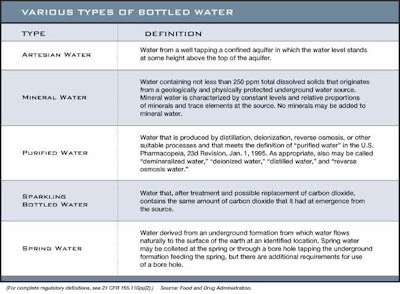There's more because there is a rather elaborate regulatory framework controlling the contents and labeling of water marketed in bottles, though few consumers know that.
There's less to it in the sense that if you are drinking bottled water as an elixir, a panacea, an antidote to all sorts of unpleasant health effects, or even perceived negative effects of public drinking water, in many cases, you may be kidding yourself.
Bottled water is now so ubiquitous, it is hard to remember a time when there was no bottled water and almost as hard to remember how humorous it seemed when it first emerged. For a while there, like the Walkman and the SUV, the bottle of water invited sneers and resentment and accusations of snobbery.
That's not generally so anymore. Bottled water is everywhere, its types are quite varied, and the reasons people drink it are varied, too. Packaging is probably a key for many—plenty of people drink bottled water simply because it's in a bottle. And the convenience of a lightweight, plastic container is, for many people, the one and only selling point of the bottled water experience. They aren't thinking that the water is cleaner, purer, or more healthful than tap water. It's largely marketed together with soft drinks, so it provides consumers with an alternative to sweetened, flavored, or carbonated beverages.
Plenty of others drink it simply because they prefer the taste, which some consumers prefer to tap water, the taste of which can vary around the nation.
Then there are those who have convinced themselves that municipal tap water somewhere or everywhere is somehow toxic to them, so they avoid it and drink only from bottles.
Waters that naturally contain minerals may provide some additional health benefit over those that don't. And, given the ever-expanding realm of functional foods, resulting in more and more waters containing added nutrients or flavors, it may be harder all the time to give a single answer to the question of why people drink bottled water.
Even as bottled water is a fixture in the U.S. marketplace, few consumers are aware of the extensive regulatory framework that controls it. Bottled waters are the subject of definitions, standards of quality, and Good Manufacturing Practice regulations. Bottled water products are regulated as “food” under the Federal Food, Drug and Cosmetic Act, and must meet quality standards set by the Food and Drug Administration for contaminant levels. Those levels are set by FDA, it says, “in response to requirements that the Environmental Protection Agency has established for tap water.”
Definitions are provided by FDA for groundwater, purified water, mineral water, artesian water, spring water, sterile water, well water, and sparkling bottled water. (See chart with some definitions on p. 29).
Bottled water is supposed to be packaged and held in accordance with Good Manufacturing Practices, and bottled water facilities are subject to FDA inspection. As with GMPs for any food, these regulations, in 21 CFR Part 129, encompass the whole operation, from plant construction and design to sanitary facilities to equipment and procedures, to processes and controls. A 2002 FDA article indicates that “FDA's experience over the years has shown that bottled water has a good safety record,” and therefore, the plants where it is bottled “generally are assigned low priority for inspection.” If a plant had past violations, the frequency of its inspection is likely to increase, however. Consumer complaints or other suspicious information will also help bring FDA to a plant's door. State agencies are also involved in regulating bottled water, often focusing on the water source itself.
Because bottled water is a type of food and is regulated as such, its packaging is also regulated as a potential food additive, just as it is with respect to any other food. Plastics and other materials used to contain bottled water must have the appropriate FDA approval for that use.
In fact, there was a report earlier this year of some bottled water brands from Canada and Europe being found with antimony, and the PET bottles they were held in was suspected as the source.
As the antimony episode demonstrates, bottled water has not been free of controversies, even beyond those related to anti-yuppie bias and other snide cultural controversies. According to the International Bottled Water Association, in a late August statement, a recent recall of some bottled water in New York State resulting from elevated bromate levels was a demonstration of the effectiveness of the regulatory controls in the bottled water marketplace. The IBWA statement says the recalled water “was not in compliance with FDA's 10 parts per billion standard for bromate,” which, the IBWA points out, is the same standard of quality for bottled water and tap water. Unlike tap water, however, specific product lots of bottled water must be in compliance with FDA standards. Tap water, says the IBWA, need only meet an annual average level of bromate.
The IBWA has a Bottled Water Code of Practice for its members, which it says in some respects is more stringent than federal and state requirements.
As with any other food product, there have been instances of overstatement of benefits or of quality, some of them actionable as false or misleading statements in violation of FDA strictures. Critics point to misleading claims that water is “pure” or is “spring water” when it's not. Yet they also complain about waters touting “natural” or “healthy” or “premium,” but these terms fit squarely into the realm of advertising puffery rather than regulatory specifications. It is hard to say whether the bottled water industry is plagued by more than its share of problematic products or label claims.
One suspects that critics are unduly sensitive simply because the product is water. There is a sense that water is so basic and so familiar that people are irritated that anyone puts water in a bottle at all. It seems to offend them that anyone would make any claims for water's benefits, and it seems as if it causes extra consternation when the occasional product problem or unscrupulous bottler comes along.
But it may be consumers' unrealistic expectations that are really at play here. The bottom line is that bottled water is a regulated industry. Its bottlers and their products are subject to controls on the product quality, manufacturing, and label claims. That doesn't mean it's a perfect industry. It does mean, though, that it isn't always exactly what consumers think it is, because of their own biases and expectations.
Eric can be reached at [email protected]


























